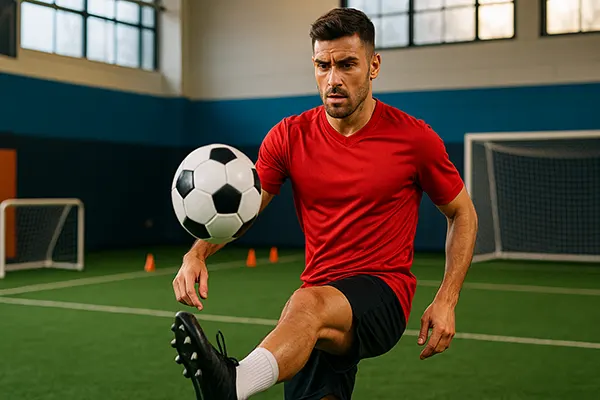
Professional Athletes as Ambassadors for Gaming Brands: Where Is the Line?
In 2025, the alliance between sports and gaming has become more than just a crossover — it’s a structured commercial phenomenon. As professional athletes represent top gaming products, questions about influence, ethics, and value have reached new levels of public discussion. But how far can these collaborations go before the line between sport and digital entertainment is blurred beyond recognition?
Star Footballers in Gaming Promotions
Prominent football players have increasingly become the face of major gaming titles and equipment. Antoine Griezmann, a long-time Fortnite enthusiast, partnered with Epic Games and even integrated game emotes into his goal celebrations, creating a feedback loop between esports and real-world sport. Neymar Jr., another avid gamer, not only played on Twitch but became a character in the game itself. These integrations are no longer simple endorsements — they are branding symbioses.
Some footballers have launched their own esports teams. Gerard Piqué co-founded KOI, an esports organisation that participates in several tournaments. This marks a shift from passive endorsement to active involvement in the gaming ecosystem. Footballers are not just faces on banners — they are stakeholders in the industry.
Gaming firms, especially those connected to sports simulations and battle royale formats, view these athletes as natural ambassadors. Their competitive mindset, huge social media presence, and global recognition make them ideal partners to penetrate both traditional and digital fan bases.
Contract Values and Commercial Success
The financial side of these collaborations is substantial. Sponsorship contracts with athletes for gaming promotion can range from $250,000 to several million annually, depending on the reach and duration. For instance, Cristiano Ronaldo’s involvement with Garena Free Fire was estimated to be worth over $1 million per year. These deals often come with multi-platform obligations — from Twitch streams to TikTok snippets.
Aside from direct contracts, many athletes earn from affiliate codes, exclusive merch lines, and in-game character skins. This diversified revenue model offers long-term value, both for the player and the brand. It’s not just about posting a photo; it’s about community integration.
The result is an ecosystem where influence is measurable, sales are trackable, and ROI is clearer than in many traditional ad campaigns. Gaming firms see clear metrics: spikes in downloads, in-app purchases, and social engagement.
Ethical Debate: Influence on the Youth
The widespread integration of athletes into gaming advertising has triggered concerns about the influence on younger audiences. With many campaigns targeting teenagers, questions arise about the messages being sent. Are these partnerships promoting strategic thinking and digital culture, or are they encouraging addictive behaviours and impulsive spending?
Experts in digital ethics warn that the line between promotion and manipulation is thin when athletes — viewed as role models — front free-to-play games that rely heavily on microtransactions. Many titles adopt monetisation strategies resembling gambling, such as loot boxes and paid battle passes.
This is especially critical in markets with loose regulation on digital advertising. While disclaimers and sponsored tags are legally required in many countries, enforcement is patchy. This creates a grey area where influence can quickly become undue pressure on young consumers.
Public Backlash and Policy Responses
Countries like the UK and Belgium have launched consultations about athlete-backed gaming promotions. The UK’s Committee on Advertising Practice issued new guidelines restricting celebrity involvement in ads for games aimed at under-18s. Although enforcement remains a challenge, the cultural pushback is growing.
Social media also plays a key role in backlash. When players promote games involving in-app purchases without clear warnings, they often face criticism, not just from regulators but from their own fan bases. This pressure has forced some athletes to clarify or even terminate contracts.
As awareness of digital ethics grows, many athletes now choose partnerships with firms that prioritise transparency, educational content, or responsible gaming practices. It’s a reputational move that protects both the athlete and their younger followers.

Reverse Trend: Gamers in Sports Marketing
Interestingly, the influence flows in both directions. Prominent streamers and esports stars are increasingly present in traditional sports marketing. Ninja, known for his Fortnite fame, appeared in Adidas campaigns. Spanish streamer Ibai Llanos collaborated with LaLiga and even organised sporting events watched by millions.
Brands like Nike and Puma have launched limited-edition gear lines targeted at the gaming community, using well-known gamers as models. These campaigns are not mere novelty; they’re commercial successes, blending gaming aesthetics with athletic appeal.
This trend is also supported by audience data. Studies show that fans of esports often overlap with those of mainstream sports, particularly among Gen Z. As such, including a gamer in a football boot commercial no longer seems odd — it’s strategic brand alignment.
Sports Leagues Tapping into Esports Stars
Several football clubs now have dedicated content arms featuring gamers. Paris Saint-Germain and Manchester City have esports divisions that employ pro players and streamers. These clubs realise that engaging fans through digital-first content requires authentic voices from within the gaming world.
Furthermore, gaming influencers host events in stadiums, commentate exhibition matches, and even appear on club podcasts. Their presence brings fresh content formats, and in turn, connects sports brands with digitally native fans who may never attend a live match.
This reversal of roles demonstrates the shifting balance of influence. Where once athletes lent credibility to digital ventures, now gamers bolster sports’ relevance in an increasingly virtual media landscape.
